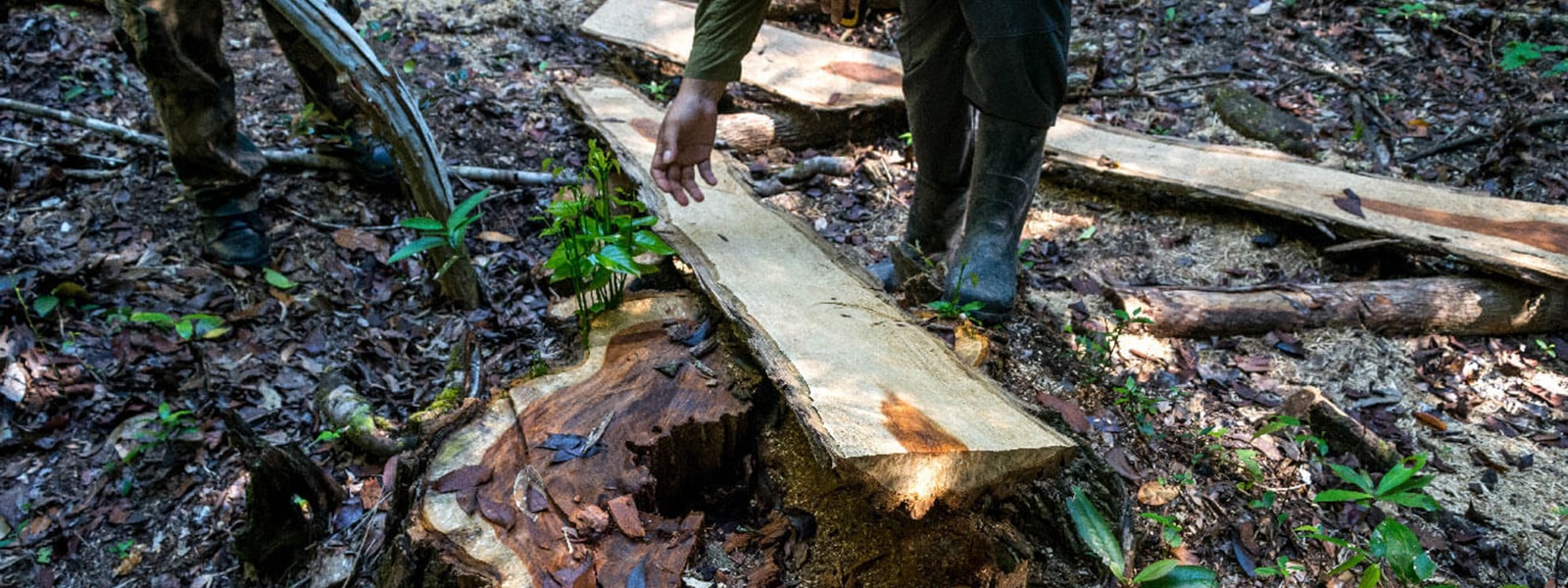
A journey deep into the jungle reveals how a shadowy timber mafia with ties to Asia is illegally extracting precious wood on the Guatemala-Mexico border. InSight Crime traveled over 300 kilometers through a trio of nature reserves to document how illegal loggers have ravaged some of the region’s most biodiverse forests and chronicle the unlikely story of a small group of park rangers fighting back.
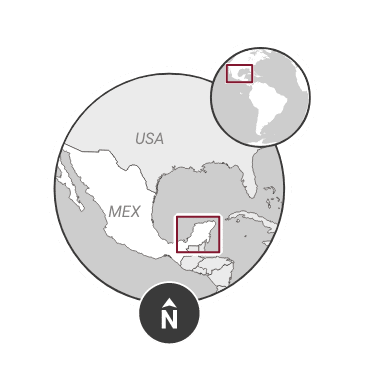

Deep in the jungles of Petén, a department in the extreme north of Guatemala, a group of elite park rangers and military officials were waiting in silence, chest-down on an anthill.
They were hiding in order to ambush a group of illegal loggers seeking a much sought-after but protected type of wood known as granadillo. Its robustness and elegance make it a popular choice for furniture, yachts, and musical instruments, despite a ban on exporting the endangered species.
Hours passed. Red and black ants began gnawing at the rangers all over their bodies but the adrenaline pumping through their bodies prevented them from feeling the stings. There they remained, tired, hungry, and plastered in mud but committed to protecting the forests along the Guatemala-Mexico border.
It was the morning of May 3, 2020. Days earlier, the park rangers had spotted the loggers camping out near the border. They saw two vehicles, customized to carry wood, as well as a campfire and scraps of food. In the distance, they could hear the sound of chainsaws slicing through trees far older than them.
The plan was to catch the loggers red-handed. That’s why the rangers were with soldiers, whose authority they need to make arrests. Around 11:00 am, they saw two loggers approaching, chainsaws in hand. When they got close enough, the rangers and soldiers quickly surrounded them, covering their eyes and mouths, and moving them 100 meters away so they couldn’t alert their companions.
A few hours later, the rangers heard an odd-sounding bird noise: “coo, coo.” It was a covert message the loggers use to give the all clear. One of the soldiers responded: “coo, coo.” And minutes later, another five loggers appeared.
Two of them bolted upon seeing the authorities but were immediately caught. Others soon followed. Six hours in, the operation had rounded up seven loggers – most of them Mexican, from the state of Campeche bordering Guatemala.
These were not the first such arrests. Since 2018, the rangers had been fending off a shadowy network of illegal loggers that came to Guatemala in search of granadillo when reserves in southern Mexico began to wane.
Over a year after the operation, in November 2021, InSight Crime joined the convoy of park rangers on both sides of the border, spending two weeks deep inside the Mayan jungle to document the incursions of criminal groups.
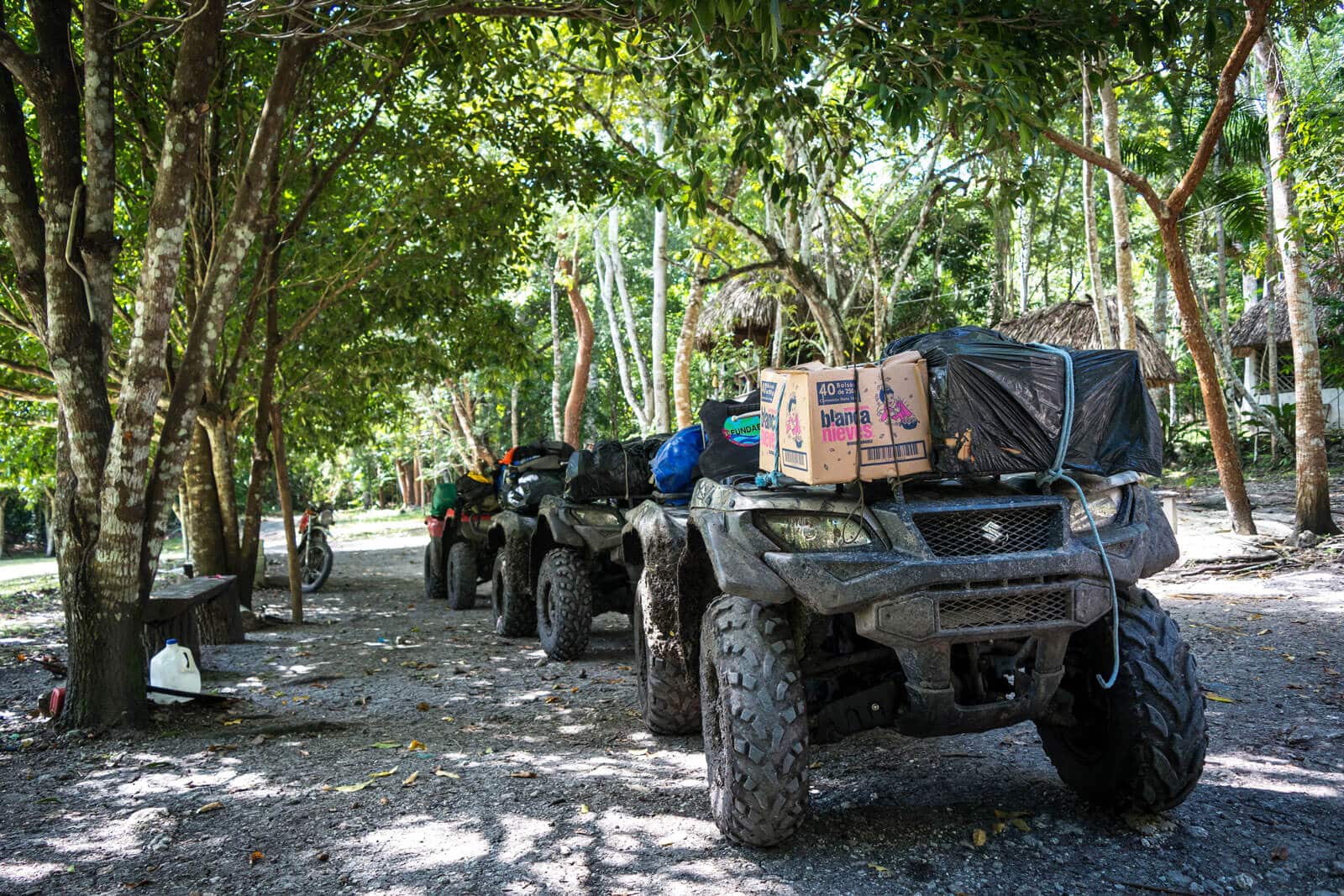
CHAPTER 1
A New Beginning:
Genesis and the Battle for the Jungle
Chapter 3
Chapter 5
Chapter 6
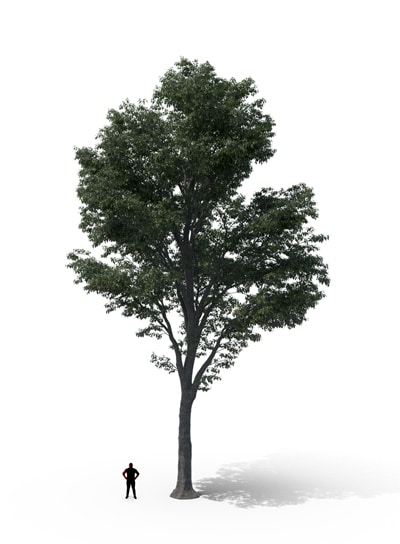
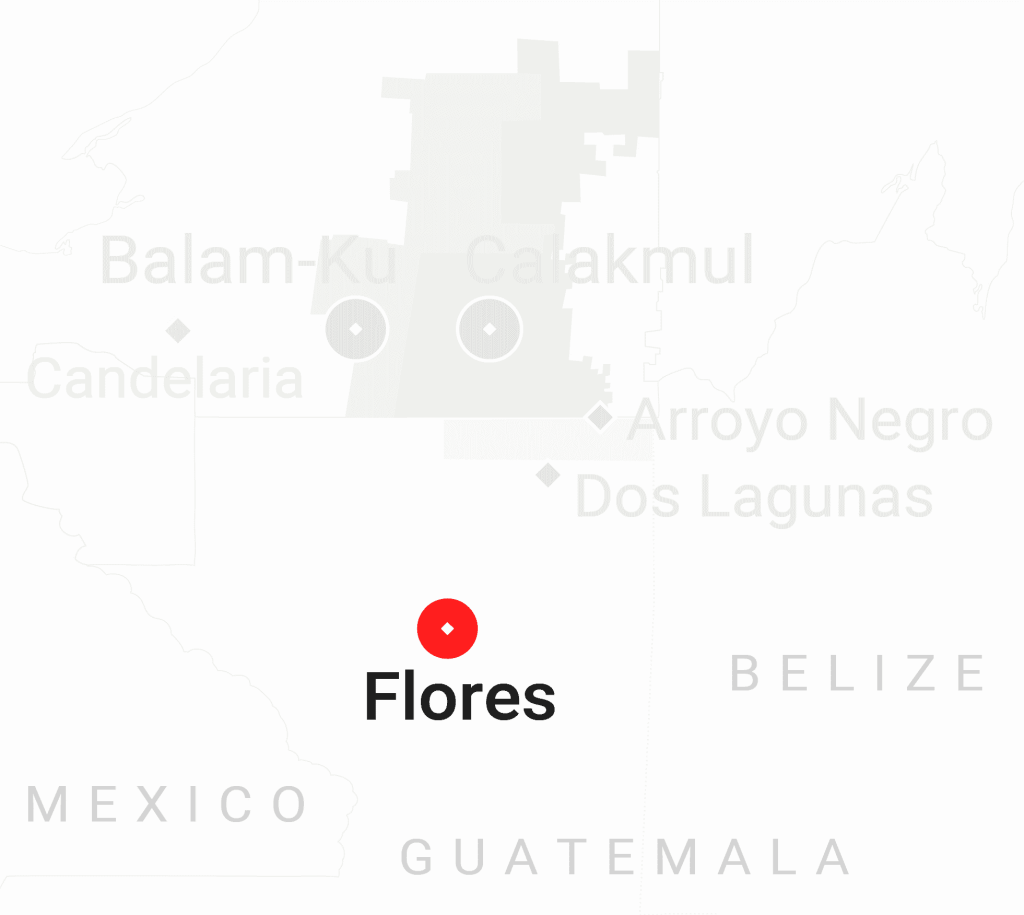
On the morning of November 8, InSight Crime headed outside of the town of Flores in Petén, northern Guatemala, to the headquarters of the Foundation for Ecodevelopment and Conservation (Fundación para el Ecodesarrollo y la Conservación – Fundaeco). This non-governmental organization was set up in 1990 with the aim of supporting conservation efforts at the local, national and regional level.
It watches over the Maya Biosphere Reserve, a protected area that spans more than 2 million hectares and houses an estimated 2,800 plant and animal species. Leading the organization’s efforts in Petén is Francisco Asturias, a veteran park ranger with over 30 years’ experience patrolling the jungle for the government and organizations like Fundaeco. Paco, as his team calls him, has gained respect over the years. This is not only because he has commanded operations against criminal groups operating in the nature reserves but also because, at 61 years of age, he is still patrolling the jungle. He does not tolerate being shackled to a desk.
The walls of Paco’s office are crammed with photos of jaguars he has chanced upon over the years. A bearded man with graying hair and of middling height, Asturias wears a full khaki uniform, his waistband fitted with a holster storing a pocket knife and a GPS phone, used to keep tabs on his team of park rangers from Fundaeco and the National Council of Protected Areas (Consejo Nacional de Areas Protegidas – Conap) – two organizations tasked with patrolling Guatemala’s nature reserves.
“My fight is for the Mayan jungle,” Paco said. “My dream is to integrate [the nature reserves in] Guatemala, Mexico, and Belize to protect [the jungle], because the Mayan jungle is the most pristine and wildest in Mesoamerica.”
He goes on to tell us that, starting in 2018, the park rangers began to encounter various criminal groups operating on the Guatemala-Mexico border. More precisely, he says, illegal loggers have been crossing the border from Mexico into Petén’s nature reserves in the hope of extracting granadillo – an internationally protected wood species highly coveted on the Chinese market. In response, Paco and the park rangers have ramped up their patrols.
Paco has lost count of the number of accusations filed against the loggers. But, according to Guatemala’s Attorney General’s Office, there were at least 62 criminal complaints between 2018 and 2020 involving alleged loggers, middlemen, and even public officials.
In this first meeting, Paco prepares us both mentally and physically for the trip. He introduces us to his most experienced guides, Emilio* and Gabriel, who remain silent as we chat with Paco, smiling from time to time.
The next day, at 6:00 am, we’re back in the office, getting ready to head out with the elite group of rangers whose patrol we’ll be joining.
The group is called “Genesis” – a squad of about two dozen seasoned park rangers from Fundaeco and Conap that serves as the first line of defense for protecting millions of hectares of virgin forest. Most of the time, the rangers patrol in small teams and without weapons, despite the risk they face from criminal groups. And though they have been left with the mammoth task of protecting these vast and resource-rich nature reserves, the rangers can only make arrests with the help of the Guatemalan military and police, who accompany them only sporadically.
Paco explains the logic behind the group’s name: “It’s a new beginning.”

The Genesis rangers spend weeks on end patrolling the Mirador-Río Azul National Park and the adjacent Naachtún Dos Lagunas Biotope. These are two of the Maya Biosphere Reserve’s worst-affected areas when it comes to timber trafficking, according to a private, independent assessment of illegal logging dynamics in Guatemala and Mexico conducted by several prominent environmental organizations and shared with InSight Crime.
With the smell of gasoline in the air and the all-terrain vehicles (ATVs) laden with supplies, the rangers pack machetes, knives, and a GPS, as well as food, tents, mosquito nets, dozens of gallons of fuel, some tools, and spare parts. Minutes later, the most experienced rangers don bulletproof vests.
“Have you ever had to use that?” we ask Gabriel.
“Thankfully, no,” he says dryly, with a hint of suspicion.
With preparations complete, the ATV convoy sets out for the Tikal National Park, Guatemala’s best-known archaeological site, home to a series of otherworldly temples from the Mayan age, restored by archeologists decades ago.
At the park entrance, guarded by the military, we stop to eat roast chicken and tortillas. At this first pit-stop there’s also soda, plenty of jokes, and a cloud of cigarette smoke that helps to lower the adrenaline and repel the swarms of mosquitoes.
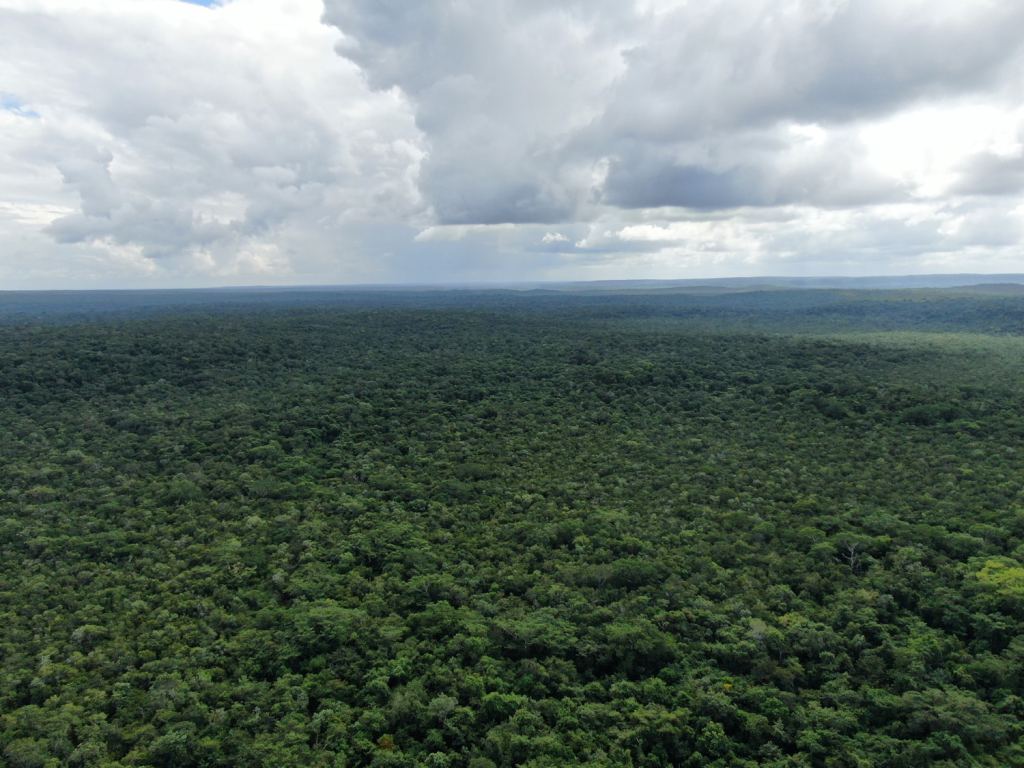


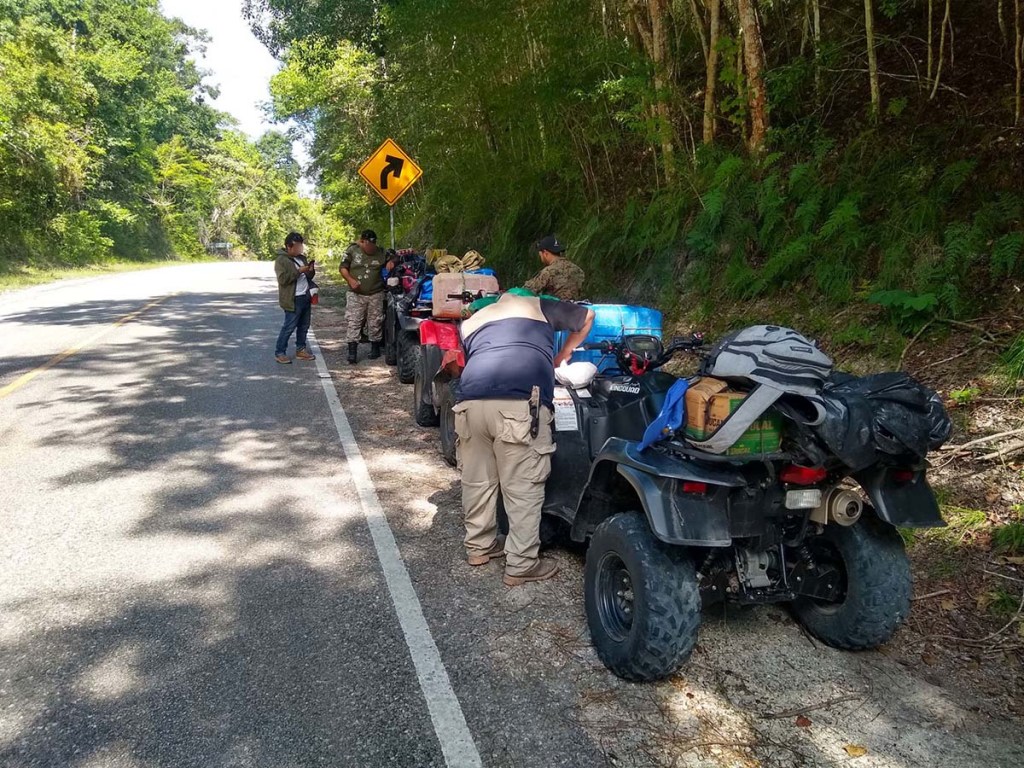
Leading the caravan are Emilio and Gabriel. The former is an easy-going, affable man who keeps the team communicating with one another. A natural leader, Emilio’s charismatic presence alone is enough to keep the loggers on their toes. The latter, Gabriel, is more reflective, silent, constantly on the lookout for traps set by his enemies. No one moves forward unless he ensures the path is safe.
Passing through Tikal, the jungle consumes us more and more. The forest is dense and the road leads us to a small community, where we stop again to send our location as per the protocol. At this point there’s no sign of illegal logging, which is more visible on the Mexican border, we’re told by Emilio and Gabriel.
“This is the last community we’re going to see before we go in,” says a nonchalant Gabriel as he blows a puff of smoke out of his mouth.
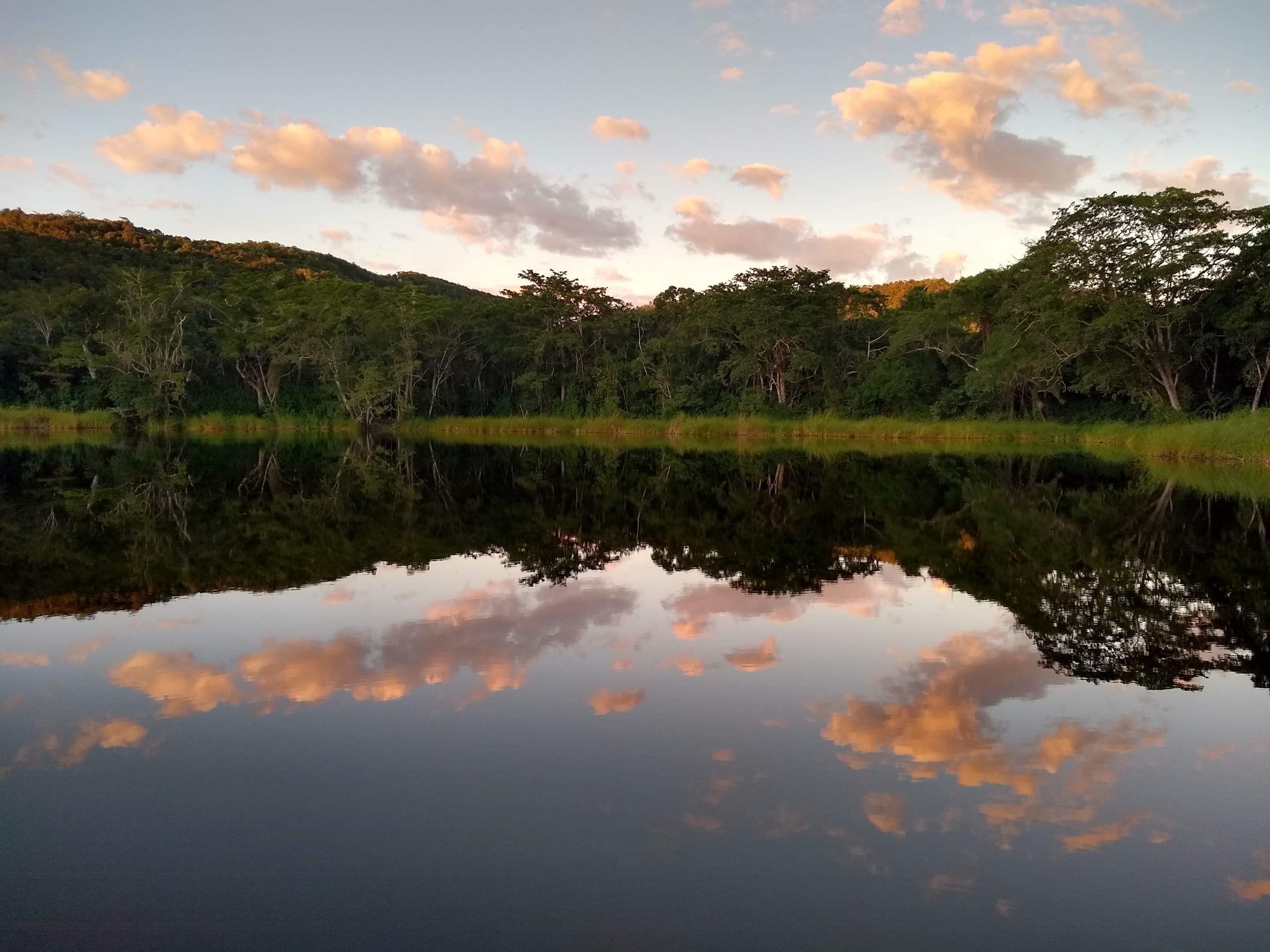
CHAPTER 2
Journey to the Center of the Mayan Jungle

Minutes later, we enter the jungle. Here begins a battle in which the forest punishes us for every minor mistake.
The muddy tracks, between one and two meters wide, are surrounded by stubborn undergrowth and impending trees. From time to time, the rangers dismount their ATVs to free them from the mud, or to use a machete to slice through thorny branches caught in the motors.
We keep our eyes open, trying to spot the crude paths loggers clear when searching for granadillo, often hidden among the endless foliage.
The most important of the group’s rules, we’re told, is that no one should ever be left behind. No wonder, since the park rangers have been held at gunpoint by illegal loggers.
“You’re going to die,” a logger told Emilio while pointing a shotgun at his head, one afternoon in April 2020. Emilio thought it was the end, but eventually talked down his assailant, warning him that a murder would bring his community unwanted attention from the state. Another time, he tells us, a logger released by a judge went looking for him at the Conap offices in Petén.
“He came to the offices looking for me, he told the doorman I had to give him back his motorcycle or he was going to kill me. The security guard didn’t let him in and went upstairs to warn me. Meanwhile, the office manager sent for a garbage truck that came to the parking lot; I got in and they managed to get me out,” Emilio recalls.


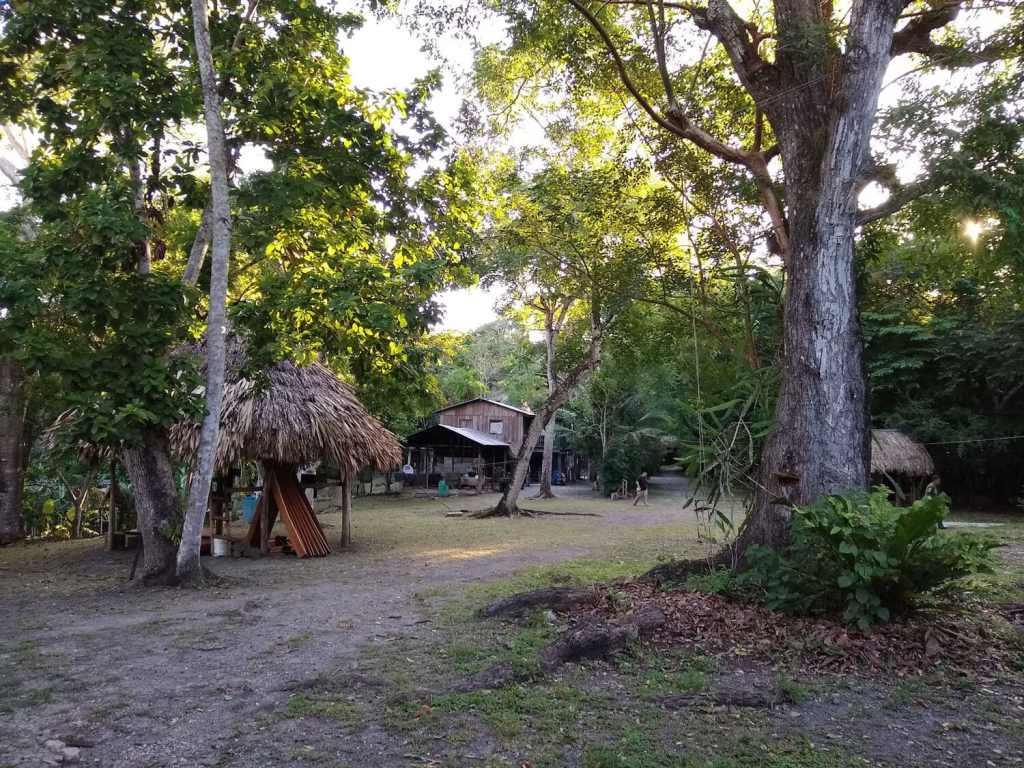

As the afternoon dwindles, after several hours penetrating the humid jungle, we briefly stop at a fork in the road.
“Say we came across a logger here, what would you do?” we ask.
“We’d assess the risk and avoid confrontation,” says Emilio. “We’d warn them and then send the location [to headquarters]. If we’re on the border and the army isn’t with us, we wouldn’t confront them because it’s a no man’s land.”
At sunset, after eight straight hours of driving, we arrive at a camp in the Naachtún-Dos Lagunas Biotope, a protected reserve covering 49,500 hectares and that provides an ecological corridor between Mexico, Belize, and Guatemala.
At the camp, nestled on the edge of a round lake that reflects the blue sky during the day, we stay in rudimentary cabins only furnished with rickety bed frames, ancient mattresses, and mosquito nets hung from tree branches.
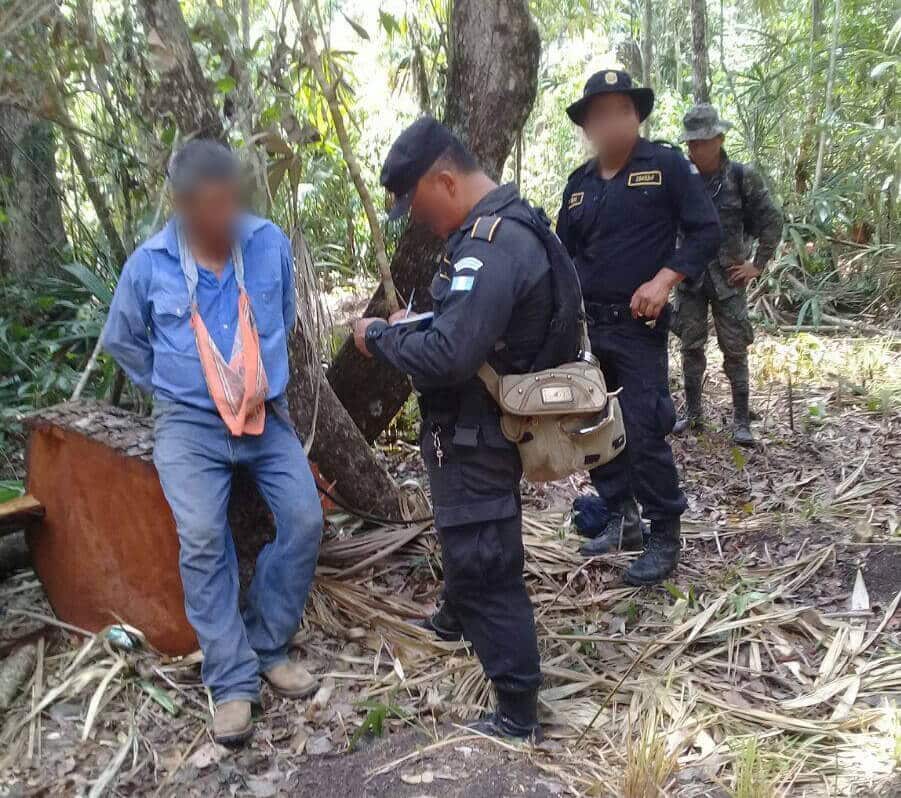
Marta, the cook who goes there every two weeks, welcomes the convoy with beans, scrambled eggs, tortillas, and coffee, all prepared over a wooden fire. By around 7:00 pm, the park rangers look close to dozing off but they still have enough energy to invite us to their camp with some rum, cola, and cigarettes.
Here, about five meters from the lake, with their sleeping bags unrolled and hammocks hoisted, the rangers tell us how they have tried to stop loggers crossing into Guatemala from Mexico.
They say Genesis increased its patrols in 2018, after their colleagues in Mexico alerted them to the arrival of loggers in Guatemala. That same year, after discovering a trailer full of timber near the border, they concluded that the loggers were entering the country from an adjacent nature reserve in neighboring Mexico, called Balamkú, northwest of Río Azul-Mirador.
Since then, the patrols have achieved over a dozen arrests for illegal logging or poaching. They have also helped document the illicit extraction of approximately 200 granadillo trees, with an estimated value of $1.4 million after arriving at ports in Mexico, according to the same independent assessment by environmental groups. The park guards do not have the resources to detect every incursion by the loggers, so the total amount of timber harvested from these nature reserves is likely much higher.


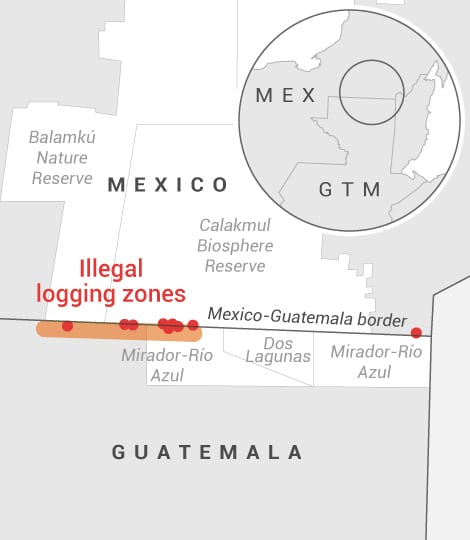
One of the biggest operations, Emilio told us, was in 2018 when the Guatemalan police and the military helped catch a group of three loggers in a place called “La Güera,” close to the border.
That day, the elite group set off at 2:00 am to reach the loggers’ camp, accompanied by police and military officers. Just as dawn broke, they spotted a red blur and caught the scent of burnt wood, a sign of campfire embers. “We didn’t even think about whether they were loggers or not. Nobody can be [on the border line] unless they’re logging or up to something bad,” Emilio says.
As they approached the camp, two of the loggers wearing only underwear sprung up and darted into the jungle. But the third, an obese man, stayed put in his hammock with an air of tranquility, as if nothing were happening.
“Where are you from? Guatemala or Mexico?” the logger asked Emilio.
“From Guatemala.”
“We can work this out. Let’s wait until noon.”
“What for?” the park rangers asked
“A colonel from the Mexican army is coming. He’s our boss. He sends us here to extract the wood and he can give you the money you need. We can negotiate my freedom, let’s wait for him,” insisted the logger.
Emilio’s story is not surprising. The park rangers often complain about how the timber mafia has managed to corrupt members of the security forces and public officials. They have little faith in public institutions. In this case, they say the logger offered $2,500 in exchange for his release, supposedly to be delivered by a colonel from Mexico’s Secretariat of National Defense (Secretaría de la Defensa Nacional – Sedena) – the government agency responsible for administering and organizing the army. Sedena did not respond to InSight Crime’s request for comment.
Neither Genesis nor the soldiers wanted a tense situation with a foreign army, so they decided not to wait. They took the logger to the Attorney General’s Office in Flores but he was soon released under a law that permits the release of first-time offenders. The park rangers describe this as a “vicious cycle.” Many judges underestimate the significance of environmental crimes, inadvertently benefitting the loggers, who often walk free in a matter of days or weeks.
The operations set off alarm bells for Genesis. What at first seemed like a small operation seemingly reached a much higher level. And so, in February 2019, Paco Asturias wrote a letter to the Guatemalan army:
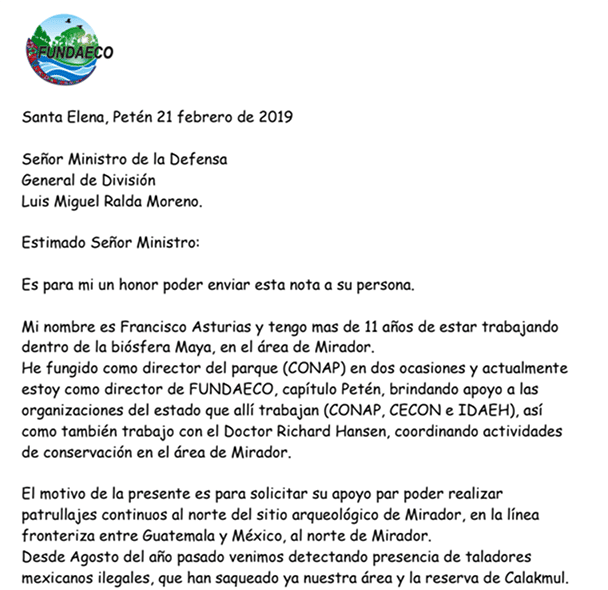
“I am writing to request your support to carry out continuous patrols north of the Mirador archaeological site, on the border between Guatemala and Mexico,” he wrote.
Paco’s letter also flagged illegal logging in the Calakmul reserve, a protected area in Mexico that shares a border with the Genesis patrol zone.
Then, in early 2020, Genesis and a group of Guatemalan soldiers arrested the seven Mexican loggers they had heard making bird sounds while ants were biting them. It looked like Paco’s letter had worked.

CHAPTER 3
Milestone 105
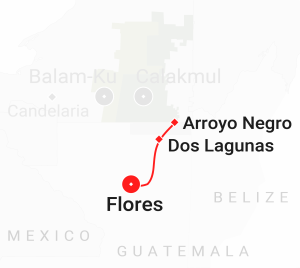
The next morning, in the middle of breakfast, Emilio looks rattled. He is no longer the charismatic leader seen the previous day. Suddenly, he comes towards us and says he’s leaving because his father is on the verge of death.
“I want you to understand how committed we are to Genesis. As we said yesterday, regardless of our personal issues, we still protect nature,” he says before leaving.
The bad news does not faze the rangers. We quickly resume the patrol and head to another camp near the border. We still haven’t seen any loggers or poachers, even though the rangers’ GPS tracker – a system called Smart – shows we’re in an area where previous patrols have stumbled upon criminal groups.

The lack of loggers is partly down to the presence of Genesis patrols in this corner of Petén. Since the major arrests in 2020, the park rangers have identified few incursions from Mexico.
“You’ll see how the Mexican side is worse off when we get there,” says Gabriel.
But before reaching the border, the ATVs once again get stuck in the mud, this time for over an hour. We finally emerge victorious after slicing a new path through the undergrowth. In the distance we can see a white concrete pillar, a milestone known as “Mojón 105,” one of hundreds that line the border between Guatemala and Mexico. This is where Mexico’s southern state of Campeche begins.
As we cross into Mexico, the jungle opens up. The roads expand from one to two meters wide to five to ten. Trucks can easily pass along here when extracting felled timber.
Within minutes, the thick jungle is behind us and we cruise across some ten kilometers of farmland on our way to Arroyo Negro, a rural community in Campeche. In this state, between 2006 and 2021, the Federal Attorney’s Office of Environmental Protection (Procuraduría Federal de Protección al Ambiente – Profepa) opened 27 cases for the illegal trafficking of granadillo.
In Arroyo Negro, we say goodbye to Genesis, the ATVs, and the mud covering us from head to toe. Soon, we embark on a three-hour drive north along asphalt roads to the nearest offices of Mexico’s National Commission of Natural Protected Areas (Comisión Nacional de Áreas Naturales Protegidas – Conanp), the government body that administers and monitors Mexico’s nature reserves. There, as a balmy evening sets in, we meet Camilo, an experienced park ranger who explains how illegal loggers have infiltrated the Calakmul Biosphere Reserve, the largest forest reserve in Mexico and which borders areas patrolled by Genesis.
It was around 2014 when the Mexican park rangers began detecting abnormal activity linked to loggers and poachers within the reserve, Camilo says. On one particularly strange occasion, a group of archaeologists stumbled upon a dead spider monkey with a gunshot wound in its chest. They knew the activities were related. Where there is illegal logging, there is poaching: a logger knows how to poach, and vice versa.
Since then, the loggers have been spreading east from the adjacent reserve of Balamkú. “By 2018, we already had [loggers] in Calakmul,” says Camilo, who asked to use a pseudonym for fear of reprisals.
The logging has not stopped, and today the Calakmul park rangers must confront a complex and organized criminal network that has so far proved difficult to contain.

CHAPTER 4
The Timber Mafia:
Dead Trees and Shotgun Shells
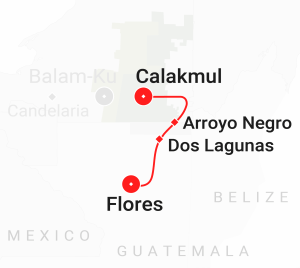
In the early hours of the following day, we’re once again submerged in the thick of the jungle, in the Calakmul Biosphere Reserve this time, accompanied by a trio of Conanp park rangers. The reserve spans some 723,185 hectares and is home to 80 percent of the plant species of the Yucatán Peninsula, in addition to almost 100 mammal species, 75 types of reptiles, 18 kinds of amphibians, and 350 types of birds.
As we listen to the songs of blue-cheeked parrots, we meet Nicasio, another veteran park ranger with a reassuring presence. We quickly climb into a six-seater ATV and head into the jungle, joined by two rookie rangers, recently hired in an attempt to bolster the patrols. Like us, they listen attentively as Nicasio guides us along the trail, occasionally stopping to point out different animals and plants.
Here, the roads are wider and more porous than in Guatemala. Travel is easier and it doesn’t take us long to figure out why.
“We are about to enter the carnage zone,” says Nicasio after around two hours of driving.
Just meters ahead, the scene of the crime comes into view. We see a rough path around 200 meters long, with various twists and turns. The locals call these brechas (breaches). At the end of the path, we find a number of trees carved up by chainsaws, piles of sawdust littering the grass and bark. There are various species here – cedars and mahogany, plus the solitary stump of a granadillo tree recently taken by the loggers.
Sitting in one of the camps where the park rangers carry out surveillance, Nicasio tells us the timber mafia is a sophisticated operation. But, he continues, it is impoverished locals who provide cheap labor for the network’s “dirty work.”
The mafia recruits local loggers who enter the nature reserve during the dry season. They find the trees and mark them with their initials, Nicasio says. Two or three days later, another group of people arrives to fell the marked trees and prepares them for transport. When they have all the trees they need, a trailer takes them away.
“It’s like that everywhere,” says one of Nicasio’s apprentices.
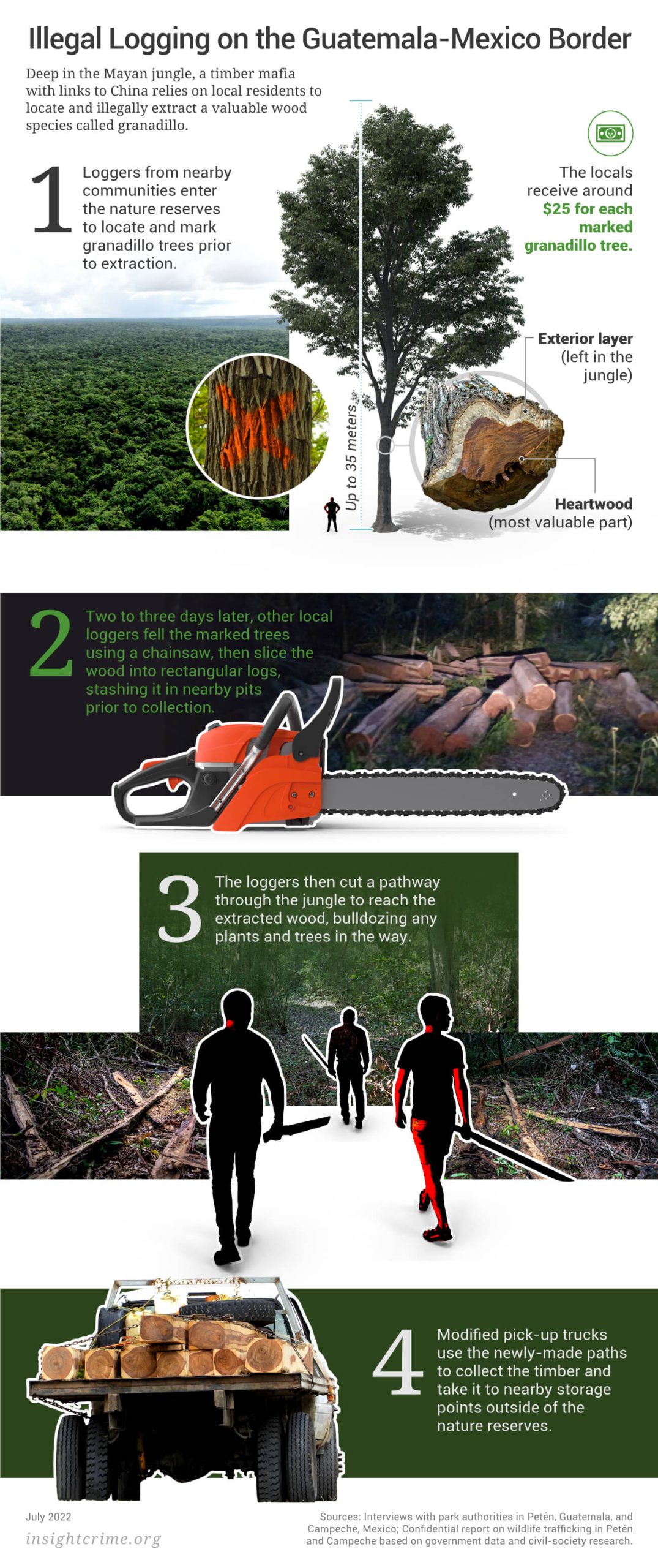
It is a highly destructive process, as the loggers can raze hundreds of meters of forest just to reach a single granadillo tree. These brechas are opened by groups of six to seven people who set up camps in the jungle, often contaminating their surroundings with plastics and fuel. The loggers also poach animals when they run out of supplies, according to the same the independent assessment by environmental groups.
The local loggers, who mostly come from poor villages in and around the reserve, can earn between 12,000 and 15,000 Mexican pesos ($581-726) per cubic meter of granadillo extracted from the forest, according to Nicasio and his apprentices. It is an enticing amount of money in communities where many work as day laborers on nearby ranches.
But it is the mafia’s intermediaries – often businesspeople living in major Mexican cities – who rake in the serious profits from illegal logging. For them, the price of granadillo per cubic meter can be up to four or five times higher when the timber is ready for export.
One cubic meter equates to a log of around 10 meters, cut into an elongated rectangle and pruned of its bark. This modification is not only for transport, it also helps disguise the granadillo as a generic type of wood with fewer restrictions on export, allowing the mafia to secure false papers for customs checks. The process is known as “wood laundering.”
The “laundering” relies on sawmills that strip the raw wood of its defining features. These workshops are ubiquitous in communities surrounding the natures reserves. Of some 366 illegal sawmills detected in Mexico as of 2012, 68 were located in Calakmul, according to Profepa.
The mafia funds the “laundering” thanks to the high price of granadillo, and this is what allows the middlemen and timber companies linked to the network to enjoy their substantial profits with the appearance of legality. The local loggers, meanwhile, risk being jailed by authorities on both sides of the border.

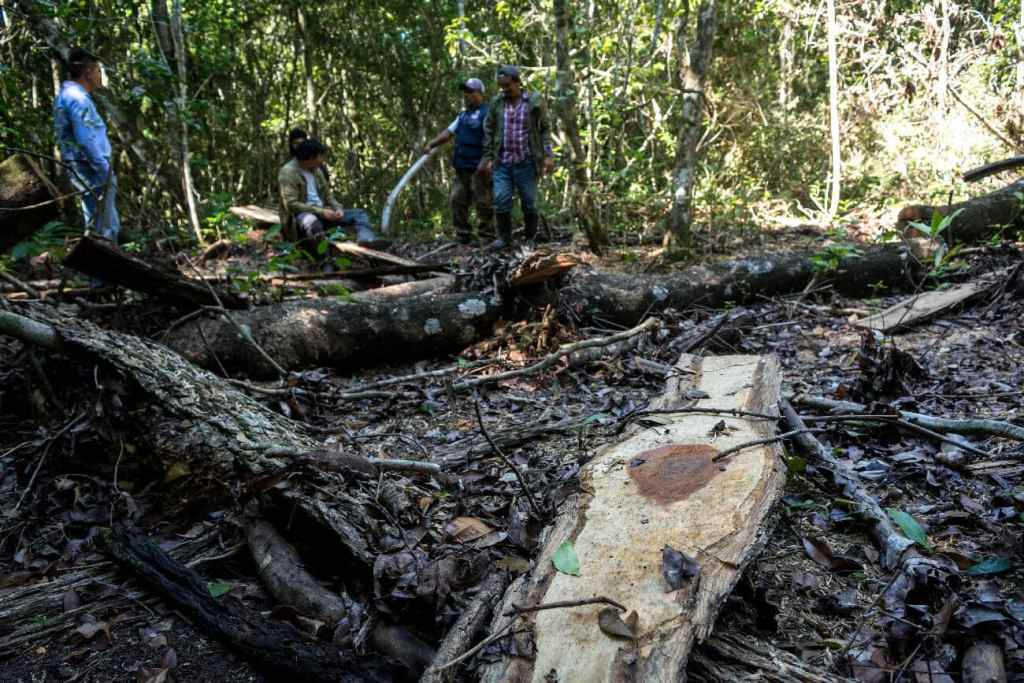
According to the calculations of Nicasio and his apprentices, one cubic meter of “laundered” granadillo is worth around 70,000 Mexican pesos (approximately $3,390) for intermediaries. These usually come from Mexico City or Yucatán, they recruit local loggers and buy up large quantities of illegal wood on behalf of clients in foreign markets.
Despite the mafia’s sophistication, the Mexican park rangers’ ranks are thin. Nicasio tells us that, at the beginning of 2021, just six park guards were covering the entire Calakmul reserve – over 700,000 hectares. That number had increased to 16 by the end of the year but most of the guards were rookies, lacking the experience of their Guatemalan counterparts.
They are also vulnerable, with no weapons or bulletproof vests. In most cases they work alone, without the police and the army, just like the Genesis rangers in Guatemala. They only receive help if they notify the country’s Attorney General’s Office (Fiscalía General de la República – FGR) in advance. But obtaining that authorization is a slow and bureaucratic process, giving the loggers time to escape.
For Nicasio, the golden period was when the so-called environmental gendarmerie (Gendarmería Ambiental), created in 2016 by former President Enrique Peña Nieto, operated a checkpoint in the reserve and was quick to join patrols.
“When we were in charge in Calakmul, no Mexicans were crossing into Guatemala to cut granadillo,” a former special operations commander of the environmental gendarmerie told us in the weeks after our trip. The body was disbanded in 2019 after current President Andrés Manuel López Obrador dismantled the country’s federal police and its specialist units, replacing them with the so-called National Guard (Guardía Nacional).
Now, the procedures are slow. “As of 2017, the army’s operations have decreased,” says Nicasio.
In Mexico, efforts to quell illegal logging certainly appear weaker than in Guatemala. This is largely due to financial restrictions; the central government slashed CONANP’s budget by over 50 percent since 2016. This left park rangers and environmental organizations without funds or equipment to adequately do their job, according to a Campeche-based environmental expert consulted by InSight Crime.
Just under 120 cubic meters of granadillo were seized in Campeche between the start of 2012 and August 2021, according to Profepa, worth around 9.4 million Mexican pesos (US$471,240), according to price estimates taken from the same independent assessment by environmental groups. But looking at open cases, there have only been four complaints for illegal logging between 2012 and 2021.
One of the patrol’s defining moments comes when one of the novice rangers bends down to pick up an object. He dusts it off. It’s a red shotgun shell. “This shouldn’t be here,” he mumbles as he looks around cautiously moments before heading back to the base.
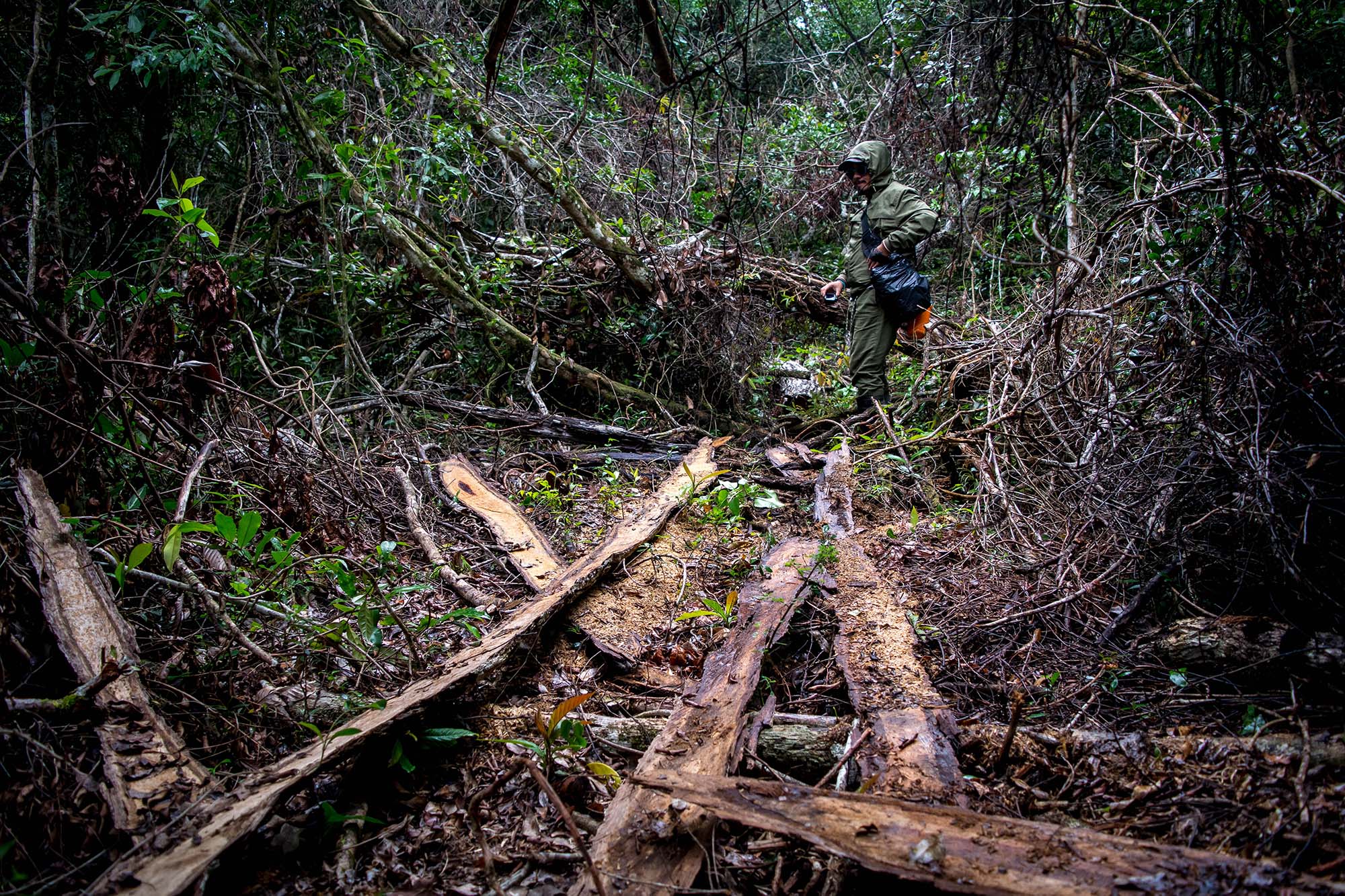
CHAPTER 5
A Forest Devoured, Park Rangers Helpless
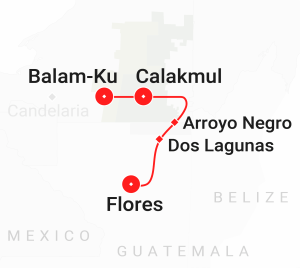
Two days later, we join a new ATV convoy with a group of park rangers stationed in the Balamkú nature reserve. Covering over 400,000 hectares, the reserve shares a border both with Calakmul and Río Azul-Mirador in Guatemala. In the five days since leaving Flores, park rangers on both sides of the border have repeatedly warned us that Balamkú is an epicenter for illegal logging.
A light rain spatters the muddy trail. The park rangers – this time a squad of nearly a dozen older men dressed in camo clothing – study the forest for clues.
Leading the pack is Ángel, a seasoned park guard sporting a walkie-talkie, GPS tracker, a camouflage sunhat, and black sunglasses. Not long after leaving base, Ángel brakes abruptly, parks his ATV, and tilts his head towards the dense foliage. At first we see nothing, but a closer look reveals a clump of trees covering the entrance to a brecha.
Seconds later, the rest of the convoy catches up, and we follow the path towards the logging site. The trail leads to a fork in the road that branches off into another pair of trials, then another, and so on for several kilometers.
All along the path, we see different types of felled timber before eventually reaching the remains of two granadillo trees. In other words, the loggers bulldozed this entire stretch of forest to extract just two trees.
“It’s selective logging,” says Ángel, pulling out his GPS tracker to pin the location.
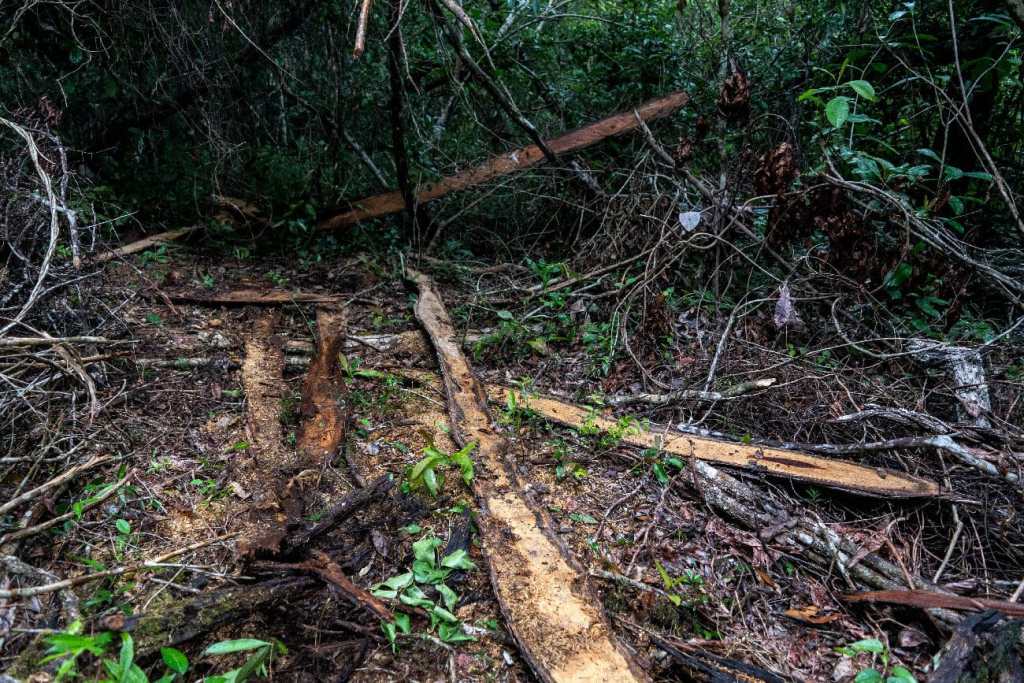
A map displayed in the same independent assessment by environmental groups shows how the brechas have spliced through hundreds of kilometers of forest in the reserve. The map is also littered with red dots indicating illegal operations.
Less than three hours into the patrol, we’ve seen at least twenty paths razed by the loggers. They have exploited the Balamkú reserve to the point of exhaustion, part of the reason these groups began turning their gaze to Guatemala and the reserves patrolled by Genesis.
A decade ago, Ángel recalls, the loggers began exploiting cedar. Then came mahogany. Then “ciricote,” a small tree used to make furniture that grows in southern Mexico and Central America. Four years ago, towards the end of 2017 and the beginning of 2018, came granadillo. And now, with granadillo reserves waning in some areas, the loggers are searching for new types of wood – including a species known as “nava” that resembles granadillo both in durability and aesthetics.
“Right now, nava has quite a high price,” he says.
The night before the patrol, we speak to one of the most experienced rangers in the group, Hernán, who takes us to see a cache of seized timber totaling over forty logs, mostly granadillo and nava. The seizures came from several operations carried out against loggers, and although the quantity is impressive, Hernán says they haven’t managed to catch any of the culprits.
He tells us the poor results are not only down to budgetary constraints but also because of possible information leaks from the authorities that accompany the rangers’ patrols. Hernán is not alone in this view. Although no state actors have been prosecuted for involvement in illegal logging in Campeche, some government authorities may participate in the illicit trade via negligence and omission, according to the private environmental assessment, which cited interviews with government officials and environmental organizations on both sides of the border.
Hernán first started to suspect the authorities accompanying the park rangers during the patrols because the information they gathered when conducting joint patrols rarely led to wood seizures or arrests.
One of the rare occasions when the park rangers seized a sizeable quantity of wood came in August 2021, when they confiscated 157 logs in the municipality of Candelaria, west of the Balamkú reserve. But the night after the operation, loggers snuck into the base and ran off with 14 of the logs.
“They made a path [to enter the base] over there,” Hernán says as he points to the perimeter. “We no longer had a night watchman, so they went in and took them.”
Balamkú’s proximity to Candelaria contributes to its headaches. The municipality serves as an operational base for the timber mafia, according to the park rangers on both sides of the border. The area is home to several smaller communities that house storage centers for illegally extracted wood and supply the mafia’s workforce – tree markers, loggers, drivers, and carpenters – according to GPS data and the private report shared with InSight Crime.
Candelaria is one of the main departure points for modified trucks heading into the Balamkú reserve to collect felled timber. They often travel at night, accompanied by lookouts on motorcycles. The loggers store the extracted wood in hidden pits. And when there is enough to fill a shipping container, the export preparations begin.

This is where “wood laundering” comes into play; the mafia conceals the granadillo tree’s characteristics and secures export papers that name a different commercial wood.
This step requires the participation of government officials, either willingly or by omission, or that of the communities with collective ownership of the forest, many of them in Candelaria, according to the same independent assessment by environmental groups.
As landowners, community members in Candelaria and elsewhere sometimes offer their names for authorization requests to extract commercial woods, and the permits are later used to “launder” wood in sawmills, according to the independent assessment.
The timber mafia’s burgeoning payroll has helped foster this type of deal in communities where agriculture is one of the only forms of income, the park rangers say. It has also made places like Candelaria impenetrable to authorities, barring major operations.
With seizures few and far between and a lukewarm response from the authorities, the park rangers in Balamkú can do little but watch as precious wood pours out of their reserve.
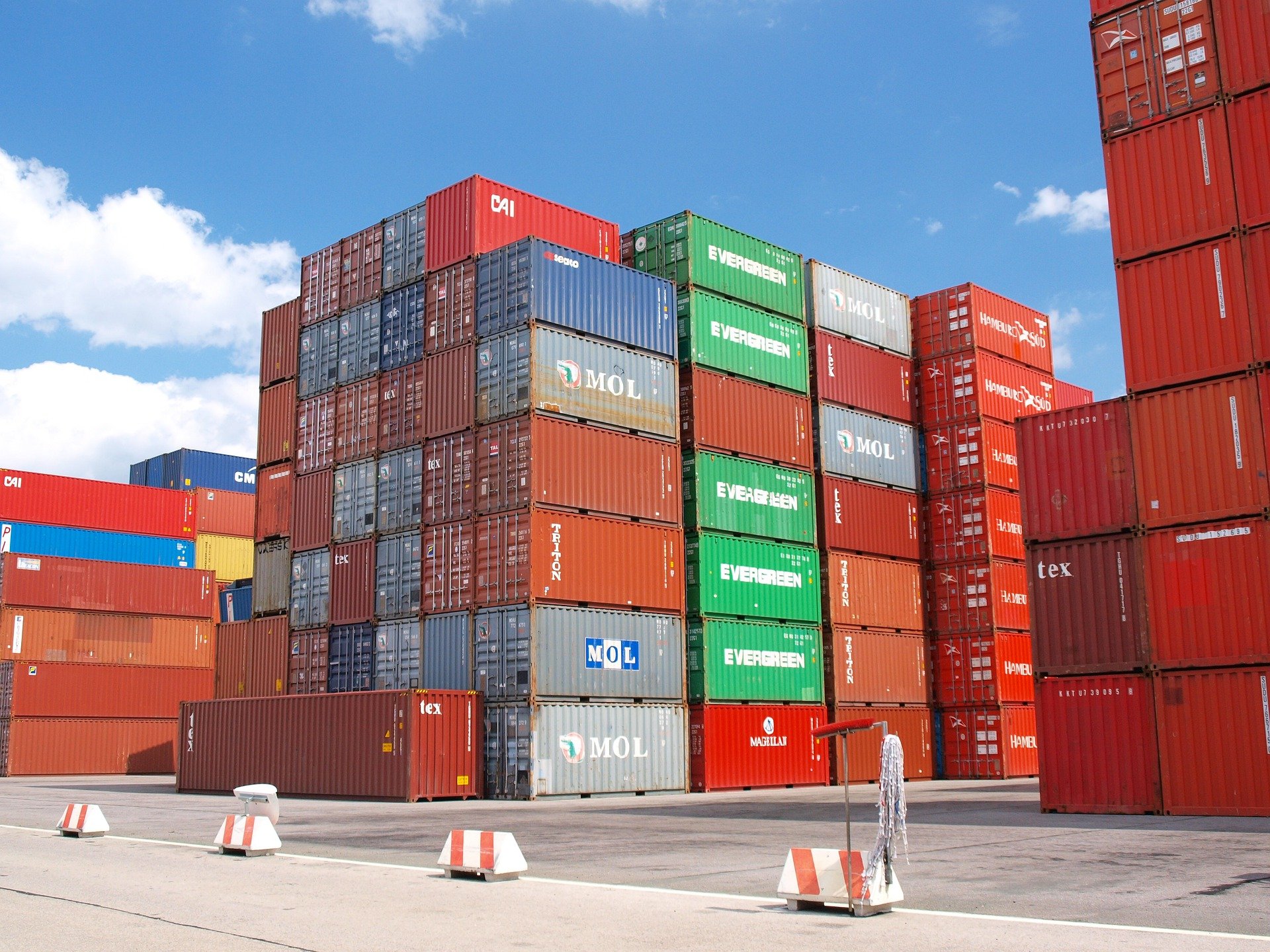
CHAPTER 6
The Shipping Route: From Mexico to China
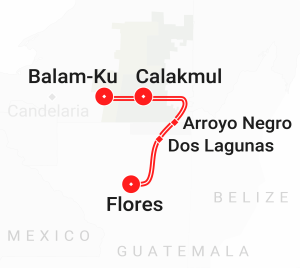
Some 450 kilometers north of Balamkú, freight trucks loaded with granadillo logs arrive at the Caribbean port of Progreso, in Mexico’s state of Yucatán. Federal authorities have flagged the port as one of the main exit points for illegally extracted timber bound for international markets.
Progreso’s importance in the illegal logging chain came into focus in June 2021, when the FGR intercepted some 27 containers – 25 housing granadillo – after receiving an anonymous tip days earlier. The granadillo, which as a protected species cannot be legally exported under Mexican law, was heading to China and had an estimated value of more than $3 million, highlighting the potential profits from trafficking this type of wood.
But it was not the end of the story. A few months later, on September 8, the Attorney General’s Office sent an official letter to the Port of Progreso’s customs office, asking for one of the seized containers to be released, purportedly because a second expert analysis had proved it was not granadillo, according to Mexican digital magazine Emeequis.
According to details of the case reported by Emeequis and verified by InSight Crime, the request to release the container came after a law firm representing Chinese businessmen paid a visit to the FGR in Mexico City and offered a sizeable bribe. The case was then shelved, with the timber mafia managing to reclaim most of the containers by sending more official letters, according to an anonymous FGR source cited by Emeequis.
The FGR did not respond to InSight Crime’s request for comment.

Seizures of this size are an anomaly. Between the start of 2020 and September 2021, Profepa made just six seizures of illegal wood at all of Mexico’s customs checkpoints, according to data sent by Mexican authorities to InSight Crime upon request.
Three of the six checks were in the Port of Progreso, with authorities finding granadillo, ciricote, and a hardwood known as “machiche.” The ciricote and machiche shipments were bound for Wan Chai, a district of Hong Kong, China, while the granadillo was initially headed to Panama. The company transporting the granadillo was Red Capitals Services SA – based in Mérida, Yucatán. The firm, which has previously exported timber to China, is not registered with Mexico’s National Companies Registry (Registro Público de Comercio – RPC).

Red Capitals Services SA has not publicly responded to the granadillo seizure. InSight Crime tried to visit the company’s offices in Mérida but the employees who greeted us said the firm had left the address at least four years ago. They refused to give the name of the entity now occupying the office space.
So far, there has been no robust FGR investigation into timber trafficking at the Port of Progreso, though investigations continue. In December last year, the head of Mexico’s Ministry of the Navy, José Rafael Ojeda Durán, said in a press conference that intelligence had found large shipments of granadillo, mahogany and cedar extracted from the states of Campeche, Quintana Roo, and Veracruz before being sent to the ports of Progreso and Veracruz.
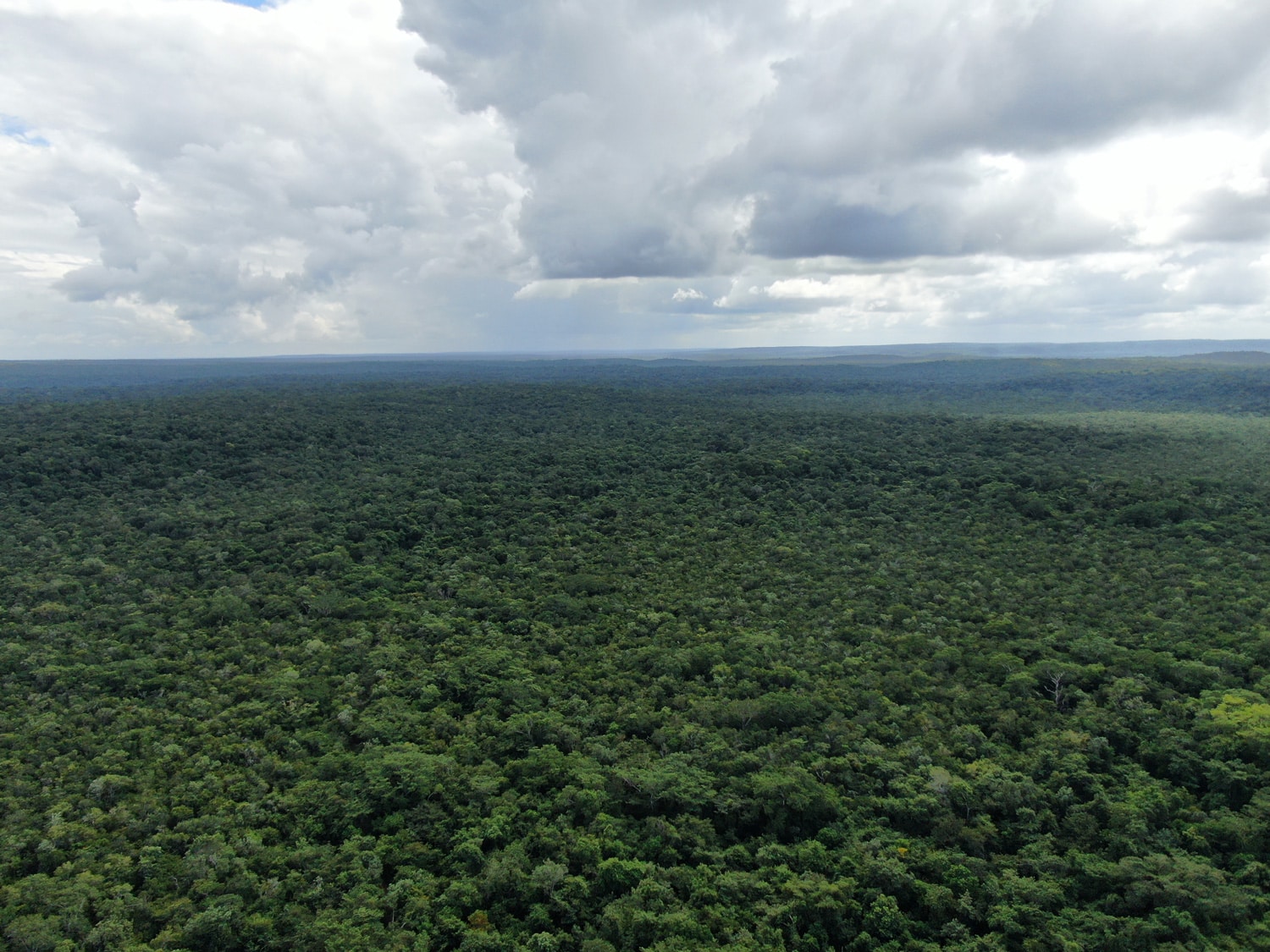
CHAPTER 7
A Brittle Resistance:
The Front Line Keeps Fighting

After a few days navigating the natures reserves in Calakmul and Balamkú, we set off on the return journey, back to Arroyo Negro and towards the border with Guatemala. There, we reconvene with the Genesis park rangers, who drive us to Milestone 105 and across the border, back into the unforgiving jungle.
It took just over a week to witness how a transnational network of illegal loggers has overwhelmed authorities in both countries and now continues its incursions into the Mayan jungle.
The park rangers bemoan the lack of funds assigned by their respective governments to the protection of natural resources as opposed to other branches of the state. Budgetary constraints make it hard to buy basic supplies and carry out repairs needed to sustain the patrols, which can sometimes cost over $2,000 for a five-day operation.
“The government is a big weakness for fighting deforestation,” said Emilio as we began the trip with Genesis.
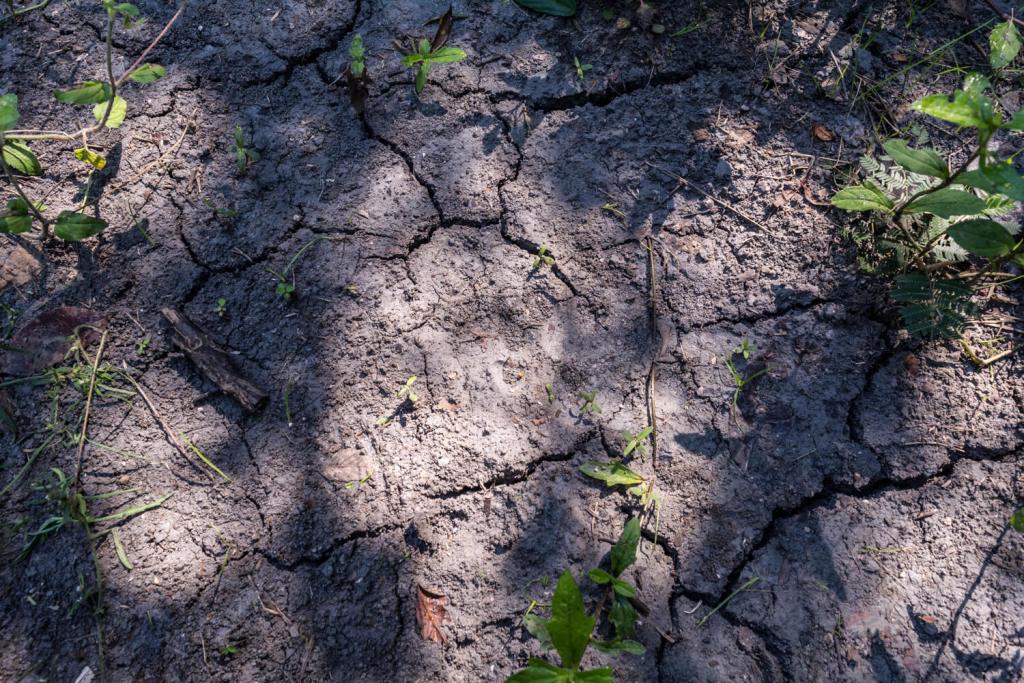
With money tight, efforts to reduce illegal logging in Guatemala, including the Genesis patrols, depend on funds provided by international donors. These include the Illegal Wildlife Trade Challenge Fund of the United Kingdom’s Department for Environment, Food and Rural Affairs (DEFRA-IWT), the Wildlife Conservation Society (WCS), the United States Department of the Interior (USDOI), and the United Nations High Commissioner for Refugees (UNHCR). Organizations such as Global Conservation and the Rainforest Trust also help fund the patrols.
Without this money, Genesis and similar initiatives would risk becoming an endangered species.
International backing has helped the Genesis rangers take the fight to a sophisticated and well-resourced criminal network. But now, there are enemies wherever they turn. The rangers tell us three of the squad’s most experienced members are seeking asylum abroad after receiving death threats.
“That’s life,” says Pablo, one of the park rangers who applied for asylum after 17 years on the job. “My wife says, ‘You’re not a ‘Rambo’ anymore who can go around risking your life. You have children.'” But although Pablo is acutely aware of the risks, he wants to keep to building a legacy for Genesis and Paco Asturias.
“They are the warriors on the front line,” Paco told us before we started the trip from Flores.

In the middle of the jungle, at a pit-stop on the way back to Flores, the howler monkeys urinate from the treetops and a group of locals collecting palm leaves passes by. Pablo takes out a cigarette, lights it, and starts recounting how his affection for the jungle began with the teachings of his father – a former park ranger. And though, in his view, he and his colleagues risk more than the government gives them credit for, there is a clear sense of pride when between cigarette tokes he says: “It will be an honor to die defending natural resources.”

